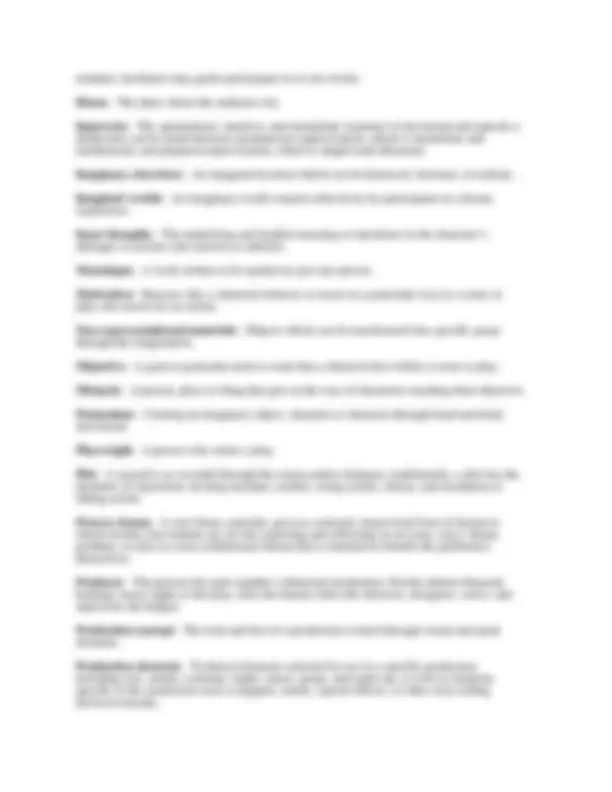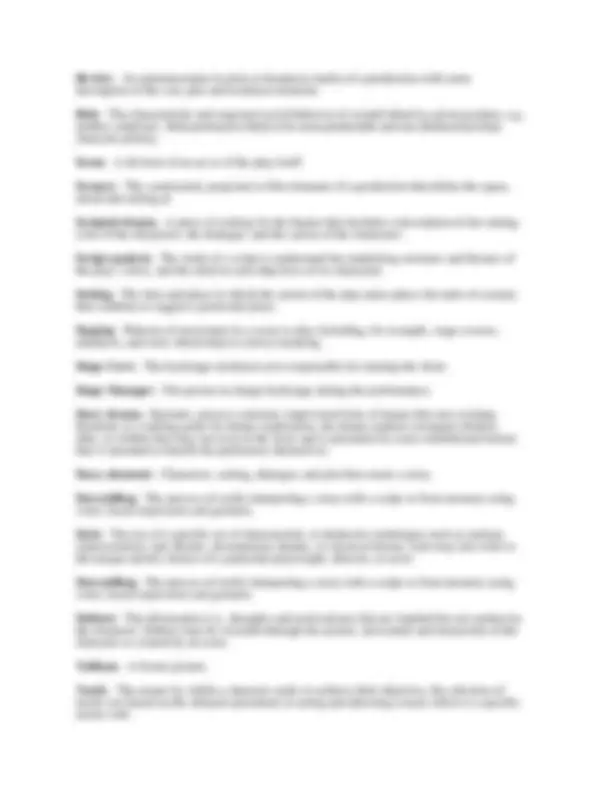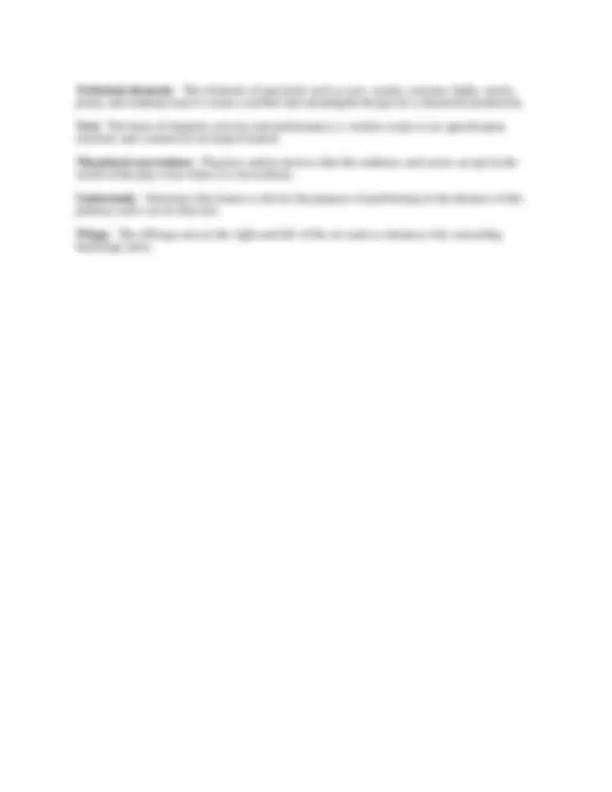





Study with the several resources on Docsity

Earn points by helping other students or get them with a premium plan


Prepare for your exams
Study with the several resources on Docsity

Earn points to download
Earn points by helping other students or get them with a premium plan
Community
Ask the community for help and clear up your study doubts
Discover the best universities in your country according to Docsity users
Free resources
Download our free guides on studying techniques, anxiety management strategies, and thesis advice from Docsity tutors
This comprehensive glossary covers essential terms used in theatre education, production, and performance. It aims to promote consistent terminology and effective communication among stakeholders.
Typology: Study notes
1 / 5

This page cannot be seen from the preview
Don't miss anything!




Theatre Glossary The glossary for Theatre includes terms commonly found in theatre education and for production and performance techniques. The intent of the glossary is to promote consistent terminology when creating curriculum and assessment documents as well as communicating with stakeholders. Actor : A person who performs a role or represents a character in a play, using vocal as well as physical techniques to bring the character to life. Acting techniques : Specific skills, pedagogies, theories, or methods of investigation used by an actor to prepare for a theatre performance. Action : The core of a theatre piece; the sense of forward movement created by the sense of time and/or the physical and psychological motivations of characters. Aesthetic criteria : Criteria developed about the visual, aural and oral aspects of the witnessed event derived from analysis, background knowledge, research, and historical and cultural context. Audition : An action-oriented interview between director and actors for the purpose of deciding who will be cast in what role; usually involves script reading, performing a prepared monologue, and/or improvisation. Backstage : The designation also applies to the wings area and, loosely, can be used to indicate anything in the physical plant that is not stage or house. Believability : Theatrical choices thought to be “true” based upon an understanding of any given fictional moment, interpretation of text, and/or human interaction. Blocking : The actor’s basic stage positioning given to the actor by the director or used in self-direction. Blocking Symbols : X= Cross E= Entrance EX= Exit C= Center SR= Stage Right SL= Stage Left DC= Down Center DSR= Down Stage Right DSL= Down Stage Left UC= Up Center USR= Up Stage Right USL= Up Stage Left RC= Right Center USRC= Up Stage Right Center USLC= Up Stage Left Center LC= Left Center DSCR= Down Stage Right Center DSLC= Down Stage Left Center Character : A person or entity (e.g., animal) in a play, or the personality of that person or entity (e.g., animal). Characterization : The art of developing the character (e.g., his/her life, emotions, choices, motivations, objectives). Character traits : Observable embodied actions that illustrate a character’s personality, values, beliefs, and history. Choice s: The decisions of the actor, director, designer or playwright regarding how a
character will be interpreted in a given production or work. Chorus : In classical drama, the chorus was used to narrate offstage events. Conflict : The problem, confrontation, or struggle in a scene or play; conflict may include a character against him or herself, a character in opposition to another character, a character against nature, a character against society, or a character against the supernatural. Creative drama : A process-centered, non-exhibitional approach to drama intended to benefit the performers themselves; story drama and process drama are two types of creative drama. Creative processes : The application of production and technical elements (see the definitions) to a theatrical production. Cue : The action or words that signals what happens next. Devised drama : Creation of an original performance piece by an ensemble. Dialogue : A conversation between two or more characters. Director : Person responsible for coordinating, guiding and developing of all aspects of a production so that the performance represents a unified vision. Dramatic play : Make-believe where children naturally assign and accept roles, then act them out. Dramaturg : A literary and production advisor to the director, designers and cast who researches the culture, period and literary references in a play. Ensemble : Harmonious blending of the efforts of the many artists involved in the dramatic activity of theatrical production to create a desired effect. Environment : Physical surroundings that establish place, time and atmosphere/mood; the physical conditions that reflect and affect the emotions, thoughts and actions of characters. Focus and concentration : Commitment by a participant (an actor, technician, director) to remain in the scope of the project or to stay within the world of the play. Fourth Wall : The invisible wall of a set or the imagined barrier through which the audience sees the action of a play. Genre : Relating to a specific kind or type of drama and theatre such as a tragedy, drama, melodrama, comedy, or farce. Gesture : An expressive and planned movement of the body or limbs. Given circumstances : The underlying actions and events that have happened before the play, story, or devised piece begins. Guided drama experience : A leader guides participants during a process drama, story drama, or creative drama experience (see the definitions) through side-coaching, narration, and prompting; the action of the drama does not stop in order for the leader to support the
Review : An announcement in print or broadcast media of a production with some description of the cast, plot and technical elements. Role : The characteristic and expected social behavior of an individual in a given position, e.g., mother, employer. Role portrayal is likely to be more predictable and one-dimensional than character portray. Scene : A division of an act or of the play itself. Scenery : The constructed, projected or film elements of a production that define the space, mood and setting.al. Scripted drama : A piece of writing for the theatre that includes a description of the setting, a list of the characters, the dialogue, and the action of the characters. Script analysis : The study of a script to understand the underlying structure and themes of the play’s story, and the motives and objectives of its characters. Setting : The time and place in which the action of the play takes place; the units of scenery that combine to suggest a particular place. Staging : Patterns of movement in a scene or play including, for example, stage crosses, entrances, and exits which help to convey meaning. Stage Crew : The backstage technical crew responsible for running the show. Stage Manager : The person in charge backstage during the performance. Story drama : Episodic, process-centered, improvised form of drama that uses existing literature as a starting point for drama exploration, the drama explores moments (before, after, or within) that may not exist in the story and is presented in a non-exhibitional format that is intended to benefit the performers themselves. Story elements : Characters, setting, dialogue, and plot that create a story. Storytelling : The process of orally interpreting a story with a script or from memory using voice, facial expression and gestures. Style : The use of a specific set of characteristic or distinctive techniques such as realism, expressionism, epic theatre, documentary theatre, or classical drama; style may also refer to the unique artistic choices of a particular playwright, director, or actor. Storytelling : The process of orally interpreting a story with a script or from memory using voice, facial expression and gestures. Subtext : The information (i.e., thoughts and motivations) that are implied but not spoken by the character. Subtext may be revealed through the actions, movement and interaction of the character as created by an actor. Tableau : A frozen picture. Tactic : The means by which a character seeks to achieve their objective, the selection of tactics are based on the obstacle presented; in acting and directing a tactic refers to a specific action verb.
Technical elements : The elements of spectacle such as sets, sound, costume, lights, music, props, and makeup used to create a unified and meaningful design for a theatrical production. Text : The basis of dramatic activity and performance; a written script or an agreed-upon structure and content for an improvisation. Theatrical conventions : Practices and/or devices that the audience and actors accept in the world of the play even when it is not realistic. Understudy : Someone who learns a role for the purpose of performing in the absence of the primary actor cast in that role. Wings : The offstage area to the right and left of the set used as entrances but concealing backstage areas.